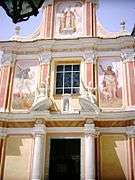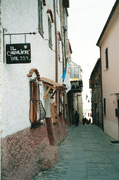Principality of Seborga
| Principality of Seborga | |
|---|---|
 Flag
 Coat of Arms
| |
|
Motto: Sub umbra sedi | |
|
| |
| Location | Seborga |
| Official languages | Italian |
| Demonym | Seborgan |
| Government | Elective monarchy |
• Prince | Marcello I (2010-Present) |
| Establishment | |
• Declared | 1963 |
| Currency |
Seborga luigino (de jure) Euro (de facto) |
| Time zone | UTC+1 (CET) |
| UTC+2 (CEST) | |
The Principality of Seborga (Italian: Principato di Seborga) is an unrecognized state that claims a 14 km2 (5.4 sq mi; 3,500 acres) area located in the northwestern Italian Province of Imperia in Liguria, near the French border, and about 35 kilometres (22 mi) from Monaco.[1] The principality is in coexistence with, and claims the territory of, the town of Seborga.
History
In arguing for the founding of Seborga in 1963, a Seborgan named Giorgio Carbone claimed, based on documents from the Vatican archives, that during the Middle Ages the town had become part of the feudal holdings of the Counts of Ventimiglia. He insisted that in the year 954, Seborga became the property of the Benedictine Monks of Santo Onorato of Lerins and in 1079 the Abbot of this monastery was made a Prince of the Holy Roman Empire, with temporal authority over the Principality of Seborga.[2]
Allegedly on 20 January 1729, this independent principality was sold to the Savoy dynasty and became a protectorate of theirs. In 1815 the Congress of Vienna overlooked Seborga in its redistribution of European territories after the Napoleonic Wars, and there is no mention of Seborga in the Act of Unification for the Kingdom of Italy in 1861. The Unification of Italy in 1861 and the founding of the Italian Republic in 1946 would therefore be illegitimate and unilateral acts because they violate the legitimate sovereignty of the people of Seborga. The exile of the Savoy, in 1946, involved also the end of ius patronatus.[3]
The argument for Seborga's present-day status as an independent state is based on the claim that the 1729 sale was never registered by its new owners, resulting in the principality falling into what has been described as a legal twilight zone.
Origins
In the early 1960s, Giorgio Carbone began promoting the idea that Seborga should restore its historic independence as a principality.[4][5]
By 1963 the people of Seborga were sufficiently convinced of these arguments to elect Carbone as their Head of State. He then assumed the style and title His Serene Highness Giorgio I, Prince of Seborga, which he held until his death in 2009.
Carbone's status as Prince was confirmed on 23 April 1995, when Seborgans voted 304 in favour, 4 against, for the Principality's constitution and in favour of independence from Italy.[6]
Politics
Monarch

Prince Giorgio I reigned until his death on 25 November 2009.[2] His successor Marcello Menegatto was elected on 25 April 2010 and crowned on 22 May 2010, styled His Serene Highness Marcello I.[7]
The monarch's position is not hereditary and elections are held in Seborga every seven years. The 2017 election was held on 23 April.[8] On 23 April 2017, Prince Marcello was re-elected and took office for another seven years after gaining 129 votes and beating his rival Mark Dezzani, a British-born radio DJ from Crawley, West Sussex, in England, who had lived in Seborga for nearly 40 years[8] and only managed to gain 42 votes.
| Title | Given name | Reign began | Reign ended |
|---|---|---|---|
| Prince Giorgio I | Giorgio Carbone | 14 May 1963 | 25 November 2009 |
| Prince Marcello I | Marcello Menegatto | 25 April 2010[9][10] | reigning monarch |
Claimants
In June 2006 a minor controversy arose when a woman calling herself "Princess Yasmine von Hohenstaufen Anjou Plantagenet", who claimed to be the rightful heir to the throne of Seborga, wrote to Italy's president offering to return the principality to the state.[11] Her claim was contested by the then-prince, Giorgio I (Giorgio Carbone), who asserted that there were no credible sources supporting her,[12] and said:
"Pah! No one’s ever even seen her as far as I know. I call her the 'internet princess'."
Since 22 February 2016 Nicolas Mutte, a French writer, claims to replace Marcello I.[13]
Crown Council

According to the constitution of Seborga, the reigning monarch has to rule under advisement by his Crown Council. Five members of the Council are elected by the citizens of Seborga while other members can be named by the Prince himself.[14] The Crown Council is the executive in the principality.[14]
| Nominative | Office |
|---|---|
| HSH Marcello | Prince of Seborga |
| Nina Menegatto | Princess Consort of Seborga, Counsellor for Foreign Affairs |
| Mauro Carassale | Secretary of State |
| Mirco Biancheri | Counsellor for Justice |
| Sabina Tomassoni | Counsellor for Tourism, History and Culture |
| Giovanni Fiore | Counsellor for Sport and Youth |
| Fabio Corradi | Counsellor for Territory, Ambient, Agriculture and Floriculture |
| vacant | Counsellor for Welfare |
| Franco Murduano | Counsellor for Defense |
| Alexandre Toesca | Counsellor for Finance |
Sport
The Principality of Seborga has an Olympic committee (not recognised by the International Olympic Committee), and a football association (not recognised by FIFA or UEFA). The Seborga national football team is a member of the N.F.-Board, and plays fixtures against other member teams, which represent various small nations, micronations, sub-national regions, and unrecognised de facto states.[15]
Military
The Principality of Seborga maintains a volunteer defence force and border guard, originally known as the Knights of St Bernard, but now simply as the Corpo delle Guardie. Members of the Corps volunteer their services, and wear a uniform principally in the blue and white colours of the Seborga flag. Guards attend the Prince and members of his family on ceremonial occasions, and patrol the streets of Seborga throughout the year. During the tourist season they mount guard at the unofficial border crossing on the main road into Seborga.[16] On its official website the Corps states its current Commander to be Luigi Zanni, and also claims that it has a mounted regiment.[17]
Gallery
Notes
- ↑ "Self-Proclaimed Micronations", WorldStatesmen.org
- 1 2 "His Tremendousness Giorgio Carbone" (Obituary) The Telegraph, November 27, 2009
- ↑ "Storia". Principato di Seborga.
- ↑ "Prince of Seborga fights on for 362 subjects", Italy Magazine, 15 June 2006
- ↑ Anneli Rufus (11 September 2014). "Seborga: The Micronation Inside Italy Where Time Stands Still". HuffPost. Retrieved 5 May 2018.
- ↑ Caitlin Moran,"Noel Gallagher is my choice for monarch", The Times, January 30, 2006
- ↑ Seborga Times, Article "Seborga will crown his new elected Prince: Menegatto I"
- 1 2 Squires, Nick (18 March 2017). "Radio DJ from West Sussex vies to become next leader of tiny self-declared principality in Italy". The Telegraph. Archived from the original on 18 March 2017. Retrieved 20 March 2017.
- ↑ Squires, Nick (27 April 2010). "Tiny Italian principality announces new monarch called 'His Tremendousness'". The Daily Telegraph. Retrieved 18 June 2010.
- ↑ "The King of Nylon: 'kingdom' of Seborga ruled by hosiery heir". The Metro. London. 28 April 2010. Retrieved 18 June 2010.
- ↑ Malcolm Moore,"Battle rages for His Tremendousness's throne", Daily Telegraph, 13 June 2006
- ↑ "Prince of Seborga fights on for 362 subjects", Italy Magazine, 15 June 2006
- ↑ Ruler of self-declared principality on the Italian Riviera faces 'coup d'etat' from rival, By Nick Squires, 21 June 2016, on telegraph
- 1 2 "Consiglio della Corona".
- ↑ List Federations Affiliated to N.F.-Board, www.nfboard.org
- ↑ The Guards of Seborga are reported and pictured in The Daily Mail.
- ↑ "Le Guardie". Principato di Seborga. Retrieved 7 April 2018.
Bibliography
- Caïs de Pierlas, Eugène (1884). I Conti di Ventimiglia, il priorato di San Michele ed il principato di Seborga. Turin: G. B. Paravia.
External links
| Wikimedia Commons has media related to Seborga. |
- (in Italian) Official website
- Official English-language blog
- (in Italian) La Gazzetta di Seborga




